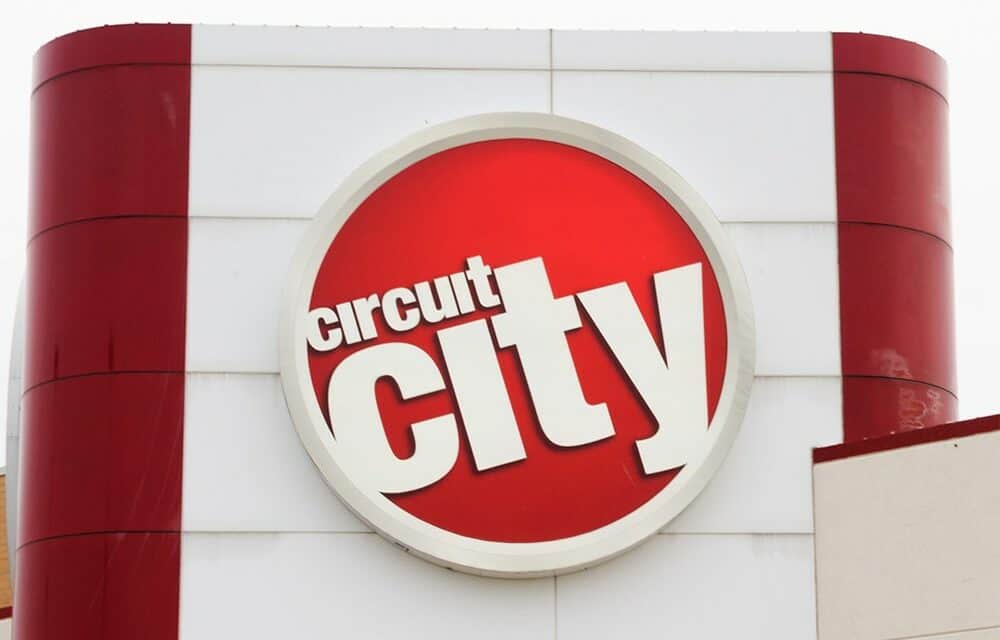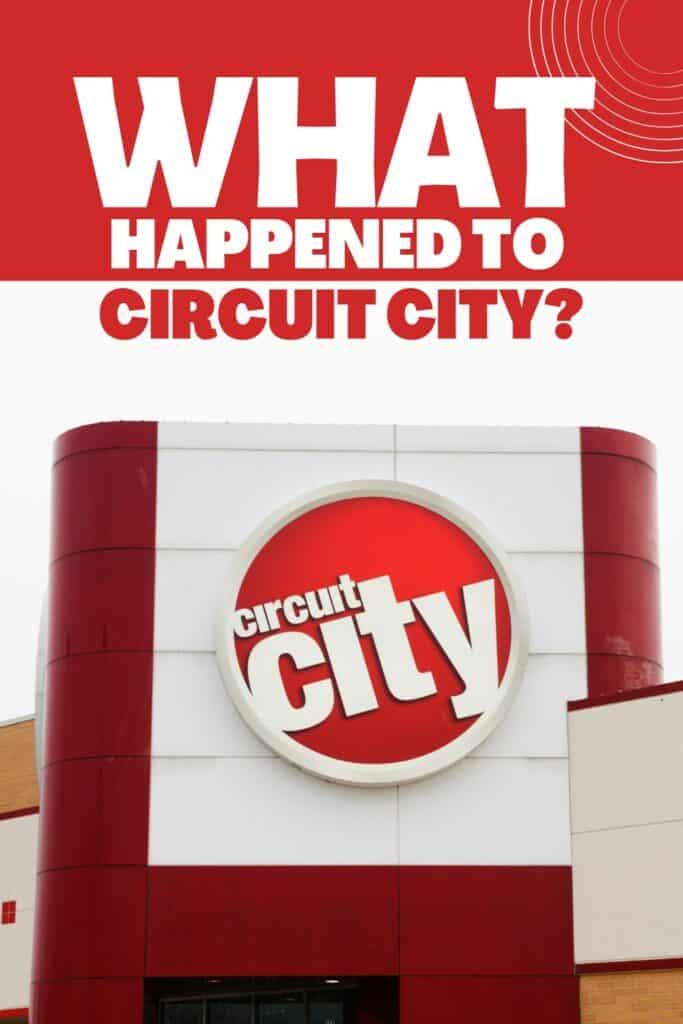Circuit City was an American consumer electronics retail firm formed as the Wards Company by Samuel Wurtzel. It had locations throughout the United States of America and pioneered the electronics superstore model.
Circuit City was founded in 1949 as a little shop in Richmond, Virginia, and has since become one of the major success stories in American retailing. Sam Wurtzel, the company’s founder, swiftly expanded it from that humble beginning into a nationwide chain, and his son Alan made it a household brand. Circuit City was at 616 locations in the United States with sixty thousand employees by 2000.
Circuit City Stores Inc. was formed after many acquisitions and a successful IPO on the NYSE.
A Brief History of Circuit City
- 1949 witnesses Samuel Wurtzel open Richmond, Virginia’s first Wards Company store.
- The first IPO is conducted by Wards Company in 1961.
- American Stock Exchange becomes the new trading venue in 1968.
- 1984 witnessed Wards Company changes its name to Circuit City Stores Inc. and is listed on the New York Stock Exchange under the ticker code “CC” after making multiple acquisitions to expand its geographic reach.
- Circuit City was the largest U.S. electronics retailer after Best Buy from 1984 to 2005. It had locations across North America and a print catalog distribution in the country that generated more than $12 billion yearly.
- 1989 saw the introduction of “Circuit City Express” at over fifty-five sites using a mall-based model.
- 2009 saw the purchase of the Circuit City brand, trademarks, and online store by Systemax (Sym).
- 2016 saw the acquisition of trademarks and e-commerce rights by Circuit City Corporation, Inc.
- In 2016, Ronny Shmoel acquired the brand name and trademark rights sold by Systemax, which had run the CircuitCity.com website from 2009 until 2012, when it was merged into the Tiger Direct brand. As part of this transaction, the brand name was reinstated.
But that is just a quick synopsis of the major milestones and important events in the life cycle of the giant electronics chain. Let’s take a look at the full history.

When and Where Cirtcuity City Started
In 1949, Sam Wurtzel, a New Yorker and serial entrepreneur, was getting his hair cut in Richmond on his way to a family vacation in North Carolina.
The barber noted that the first television station in the South had started less than a year before in Richmond. Wurtzel, who had just failed in his import-export venture, hoped that this innovative entertainment gadget would be his first breakthrough.
After World War II, commercial broadcasting started, and the first experimental television stations started in the early 1940s. A few households possessed televisions, but the medium was rapidly expanding: the number of TV stations in the United States nearly quadrupled in 1949, from 27 to 76.
Wurtzel had links to bankers and businesses in Richmond through the family. With the help of a good friend, Wurtzel got in touch with a person working at Olympic Television who was a small manufacturer in Long Island City.
In less than a month, Wurtzel had relocated his family from New York to Virginia, and he was now operating out of the front portion of a tire shop on Broad Street, a few streets west of Richmond’s central business district, where he was selling televisions.
How Did He Come Up With The Name Wards?
The store’s name, Wards, is an abbreviation for Wurtzel, A for his son Alan, R for his wife Ruth, D for his son David, and S for Sam. Wurtzel chose this name because he feared his last name could be difficult for others to pronounce.
How Has Circuit City Changed Over the Years
Strategy
Instead of going head-to-head with the large department shops, he targeted lower-income customers by providing installment payment arrangements.
He also pioneered a novel sales strategy: free in-home demos. Free of charge, a salesperson would deliver the television to a customer’s house for the evening and offer to pick it up the following day.
Once a family had the set in their house, they almost always bought it. The number of households with TVs increased from fewer than 1 million in 1949 to 20 million by 1953, demonstrating Wurtzel’s accurate prediction of the expanding consumer demand for televisions.
Marketing Appliances
Wurtzel began marketing appliances in 1952, taking advantage of the post-war need for refrigerators, washing machines, and electric stoves. Four Wards TV outlets quickly sprung up in Richmond.
A New Trend in 1953
Wurtzel quickly followed another retail trend: discount stores. The first discount shop, a massive retail facility selling a cornucopia of items at a fraction of the manufacturer’s list price, debuted in New England in 1953, and the concept swiftly spread.
A Store Inside a Store in 1960
In 1960, Wurtzel accepted an invitation from the discount retailer National Bellas Hess to launch a “licensed department,” a store inside a store, at their brand-new Atlanta site.
Eyeing a cross-country expansion, Wurtzel immediately followed up with licensed departments in Norfolk, Virginia, and Camden, New Jersey, and in December 1961, he took Ward’s TV public. Excited by its success, the corporation launched a brazen growth plan, coming dangerously close to going out of business in 1975.
Alan Taking Over As CEO In 1972
Under the leadership of Wurtzel’s son Alan, who had taken over as CEO in 1972, the business liquidated or sold several unproductive locations, and by the late 1970s, it was poised to resume growth.
The Circuit City “superstore” was born, with a new name and a new business concept influenced by the early discount stores. The superstores included a huge showroom adjacent to a larger warehouse, as well as custom-built display rooms to highlight the items.
The fact that shoppers couldn’t pick up their purchases and there was no central checkout area was most important. According to Doug Bosse, a professor of management at the University of Richmond, “Circuit City was at its greatest when buyers didn’t fully comprehend what they were purchasing and were concerned about it.” You might ask for help from a salesman at Circuit City and have them demonstrate how to use the product in your family room while you’re there.

The Years of Growth An Expansion
Circuit City superstores, which sold both electronics and appliances, grew swiftly, from eight in 1983 to 53 by 1987, in addition to the company’s 37 smaller electronics-only stores. Circuit City, like Wards TV, was in the right market at the right time.
In his biography “Good to Great to Gone’’, Alan Wurtzel writes, “I often thanked my fortunate stars that Sam had opted to go into the retail electronics industry rather than the retail shoe business.” In 1986 Wurtzel retired.
Rick Sharp stepped up as CEO, he served until 2000 as an executive vice president.
Fortune 500 Entry in 1995
Sales soared from $1 billion to $12.6 billion, profits from $22 million to $327 million, and the number of shops rose from 69 to 616 during Sharp’s leadership in 1995.
Circuit City was included in the Fortune 500 at position 280 in 1995 and reached a peak of position 151 in 2003. Circuit City was so prosperous that management guru Jim Collins included it in his 2001 book Good to Great, which examined the most prosperous businesses in the nation.
Collins, who wrote about Circuit City once more in his 2009 book How the Mighty Fall, claims that Sharp supported two initiatives that could have signaled the end for the company. CarMax was the initial endeavor, and it employed “big box” retailing to sell used cars and DivX.
CarMax 1993
After the inaugural CarMax launched in Richmond in 1993 and became an immediate success, the network quickly grew to 40 locations by the year 2000. Circuit City split off CarMax in 2002, and the company now has over 120 outlets.
DivX
DivX, a brand-new DVD technology that was introduced in 1998, proved less successful. The idea was that customers could buy a DivX-encrypted movie and then view it as many times as they wanted within 48 hours on a special DVD player. Theoretically, DivX was more practical than renting cassettes from a video rental company, but customers disliked it and other electronics retailers refused to carry DivX movies. Within a year, Circuit City gave up on the concept.

How Did Circuit City Fail?
To get customers in the door, Circuit City and Best Buy stocked a wide range of low-margin items such as computer accessories, video games, and CDs.
While Best Buy steadily grew its market share, Circuit City kept to its commission-based sales strategy and its focus on high-margin goods. Circuit City did not perceive Best Buy as a danger. According to Alan Wurtzel, who served on the board of directors until 2001, “We assumed we were wiser than everyone.”
Appliance Sales Were Stopped
The business started to undergo adjustments under the leadership of the new CEO, Alan McCollough, but the improvements seemed to backfire. Appliance sales, which accounted for 10–15% of Circuit City’s revenue, were discontinued. The decision confused both consumers and staff and could have benefited the competitors.
We were basically shoving our clients out the door while announcing that we were no longer interested in doing business with them. Circuit City eventually chose to abolish its commissioned sales staff in 2003.
Even though Wurtzel believed it was “economically vital to cut the cost of sales and to reduce commissions as a proportion of sales,” the shift was handled horribly. The best course of action, in his opinion, was to approach the salesperson in an open, honest, and reluctance-filled manner.
Buying Shares
Despite dwindling revenues, Circuit City had a lot of cash on hand after spinning off CarMax in 2002 and selling a private-label credit card bank in 2003. Circuit City repurchased shares at an average price of $20 per share between 2003 and 2007 under pressure from shareholders, spending about $1 billion in total.
Circuit City’s business was faltering, and the stock was valued at only $4.20 per share at the end of 2007. As a result, Circuit City did not have enough cash on hand to withstand the impending economic storm.
Circuit City Declared Bankruptcy
Circuit City had 567 locations and around 34,000 workers countrywide at the time of the filing. Wulf describes the firm as a “phoenix blooming from the ashes.” When that didn’t materialize, many of those same employees lost their entire life savings. In the end, Wulf claims that “all those years of investment meant nothing.”
Circuit City’s departure also created a massive void in the commercial real estate market, which was a loss not just for landlords but also for the adjacent coffee shops and restaurants that served Circuit City employees.
The Failing Steps of Circuit City
Circuit City went astray somewhere in the 1990s:
- It decreased sales of well-known appliances.
- It allowed many brilliant management personnel to leave when it split out from CarMax.
- Retail establishments became too big and impersonal.
- Circuit City stopped being inventive and started being reactive as Best Buy took off.
- It proceeded on a shop expansion binge to appease Wall Street analysts, which led to an excessive number of locations in risky areas.
- It ceased paying salespeople commissions to save money, and 3,400 of its most seasoned salespeople were later let off.
- Too many directors and C-suiters came and departed when things got rough.
After a proxy fight that granted outsiders three board seats, Circuit City finally appeared to be preparing for a strong comeback.
However, the monetary crisis and the commercial paper crunch meant that suppliers were reluctant to supply-Circuit City with items, thinking that they would be caught if the company abruptly auctioned off outlets. The company announced the closure of 155 outlets and the layoff of 17% of its workers.
As of Nov. 10, 2008, filing for bankruptcy protection was the sole course of action. And by March 8, 2009, the decision was made. They declared bankruptcy and began to close up shop. It was not a surprise to many. The writing was on the wall for a long time.
It is sad to know that a few bad decisions can tank one of the largest and most powerful companies in North America. Sadder still when you include all the lives that were affected by its closing.
Even though the trademarks and e-commerce rights have been bought, I do not think we will be seeing Circuit City making a return any time soon.










